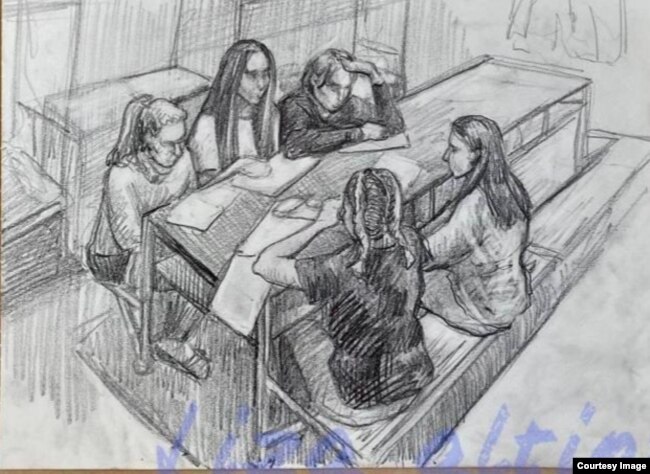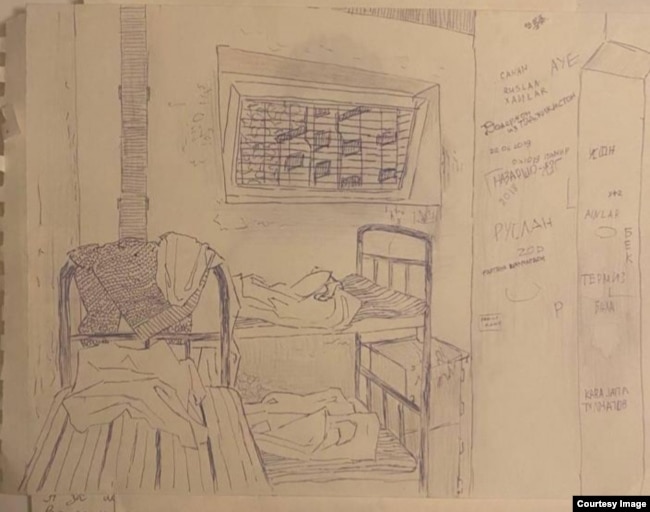Did you fall in a hole?/I did./Are you sitting in a hole?/I am./
Are you waiting for a ladder?/I am./Is the hole damp?/It is./
How’s your head?/Whole./So you’re alive?/I am./Well, off I go, then!Oleg Grigoryev
Centers for the Temporary Detention of Foreign Nationals (CTDFNs) subject to administrative expulsion or deportation from Russia have suddenly become famous. Special notoriety has been earned by the Sakharov CTDFN, which held hundreds of participants in the January protests for varying numbers of days, and the Moscow Oblast CTDFN in Yegoryevsk, which has been seared into the memories of those Muscovites for whom no space could be found in Sakharov’s overcrowded cells.
Bloggers, journalists, and political activists under administrative arrest have been able to inform the world about the dire detention conditions in Sakharov and other CTDFNs. Photographs of gloomy cells with iron cots (which initially did not have mattresses or bed linen), filthy hole-in-the-floor toilets barely partitioned off from tables where people have to eat, furniture bolted to the floor, and doors with peepholes and tray slots have flooded the internet… Someone even managed to record and send off a video showing prisoners “on a walk” in a place similar to a large cage like the ones that hold birds in zoos, with bars up to the very top, even fencing off the sky. The lively political prisoners “on a walk” chanted slogans, sang songs, and took selfies.
It’s worth comparing these photos to pictures of these very same cells and “yards” when they are filled with regular CTDFN prisoners – those same foreign nationals and stateless people “subject to expulsion or deportation.” These sad, shattered, lonely people have been sentenced to the administrative punishment of expulsion and sometimes a small fine – and not deprivation of liberty, but they are still held in the terrible conditions of an CTDFN for many months, and sometimes even years, merely as an interim measure to arrange for deportation. Expulsion is not possible in many cases, however: If people are not citizens of another country, then they cannot leave Russia legally. People whose citizenship cannot be confirmed by their country of origin also cannot be expelled. This concerns, for example, residents of the eastern regions of the Donetsk Basin, whose information is now in the hands of territories that have not been under the control of Ukraine for several years now.

Prisoner life at the Sakharovo Center. February 2021. This drawing was given anonymously to the editors.
The European Court of Human Rights (ECtHR) and, later, Russia’s Constitutional Court have found that the extended detention in an CTDFN of stateless people and other people who cannot be expelled is pointless and harsh and violates prisoners’ rights. Nevertheless, the very name of these “temporary detention centers” still retains the phrase “foreign nationals and stateless people,” i.e., people who are doomed to sit in cells and “walk” in cages.
Human rights defenders have repeatedly drawn attention to the unbearable, degrading detention conditions in CTDFNs – and this concerns not just Moscow’s Sakharov, which media outlets are now calling “a symbol of the harsh treatment of protesters.” The conditions in many oblast CTDFNs are unfortunately even worse. Now journalists have also started to focus more on this topic, since some of them have experienced (and continue to experience) all the “charms” of a stay in an CTDFN. As noted in a complaint submitted to the ECtHR by the editor-in-chief of MediaZona, “the prisoners, including the applicant, were forced to take turns sleeping, while the toilet was only separated from the general area where people ate, among other things, by an improvised curtain made by the prisoners themselves using whatever was at hand (ropes and sheets).”
The foreign nationals that some “political prisoners” are speaking about are also living in these conditions, but for a much longer time. Foreign nationals do not end up in CTDFNs as often as they used to because of the changing migration situation during the pandemic; pre-pandemic, hundreds of migrants swept up in police raids at markets, construction sites, and dormitories were brought to CTDFNs, where the cells were often as overcrowded as they were this winter, when they were occupied by better known figures. Migrant workers often do not have family in Russia and almost never have money, which means that they don’t receive packages. They have no books, games, or other forms of entertainment, they have no medicines… Some do not survive in these conditions, while others are actually born into them.
Some migrants await their transfer home not in an CTDFN, but in police-run reception centers, where political activists sentenced to administrative arrest also sometimes end up. It has now been 10 years since Russia found that the detention conditions in these centers were inhuman and totally unsuited for extended stays. Former prisoners of both CTDFNs and temporary holding centers have repeatedly said that they believe the conditions in these facilities are worse than prison-like: Pretrial detention centers and penal colonies have gyms, libraries, clubs, and even some opportunities for leisure activities, while temporary detention centers have nothing of the kind. How bitter it must be for people who have served time within the federal penitentiary system to find themselves in these centers awaiting release! But instead of their long-awaited freedom, non-citizens end up in deportation centers, since in Russia foreigner national with a criminal record are deemed “undesirable,” and are condemned to a new, extended confinement in worse conditions without being guilty of anything.

Prisoner life at the Sakharovo Center. February 2021. This drawing was given anonymously to the editors.
One hopes that people will not now forget about the harshness and injustice of the system of “temporary detention centers” and reception centers. Muscovites will leave these centers after serving several weeks in them. But people suffering from captivity, loneliness, boredom, humiliation, and illness will remain in these holes, where they are doomed to spend months, and sometimes even years, for the sake of “ensuring expulsion.”
Stefania Kulaeva
First published on the blog of Radio Svoboda









 Feedback
Feedback